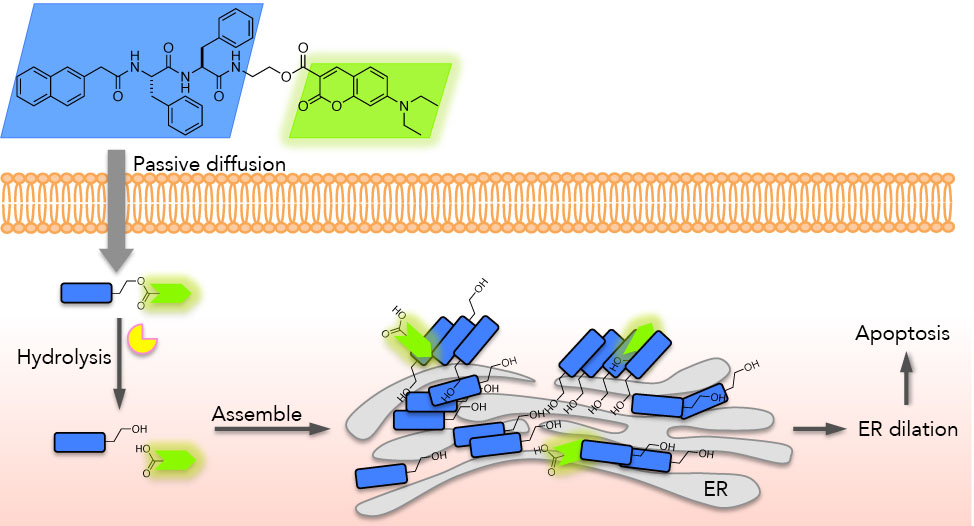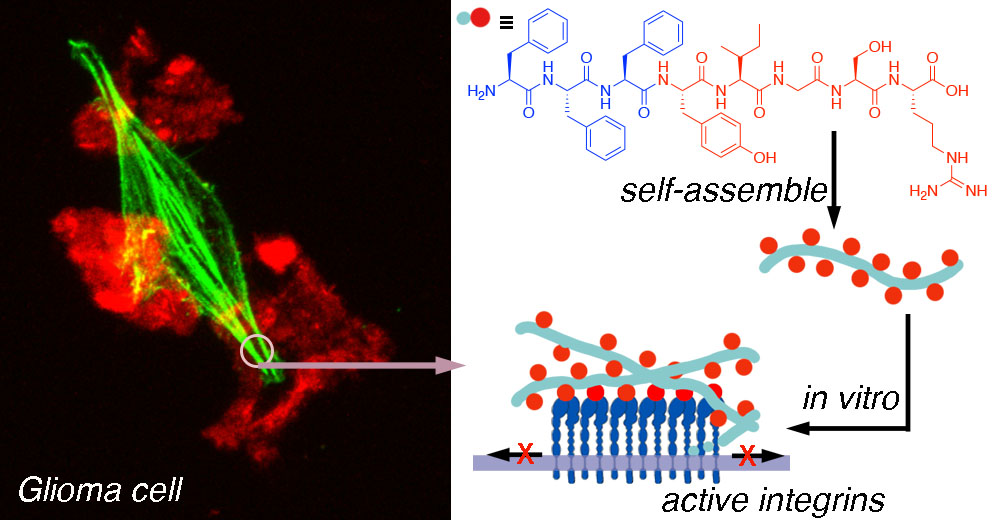FY2019 Annual Report

Abstract
Nature design materials as hierarchical architectures with complex composite structures spanning the nano to near-macro length scales to create unique combinations of properties that are often difficult to achieve with synthetic materials. The task of our research unit is to understand such amazing mechanisms and develop new man-made materials to mimic the structure, properties or performance of natural materials or living matters.
1. Staff
- Dr. Guanying Li, Postdoc Fellow
- Dr. Dingze Mang, Postdoc Fellow
- Dr. Xia Wu, Postdoc Fellow
- Dr. Chengzhi Jin, Postdoc Fellow
- Sona Rani Roy, Graduate Student
- Shijin Zhang, Graduate Student
- Xunwu Hu, Graduate Student
- Sachie Yukawa, Graduate Student
- William Cortes, Intern Student
- Hitomi Shinzato, Administrative Assistant
2. Collaborations
2.1 Regulation of Hippo-signaling via lipid-raft-targeted molecular self-assembly
- Description: Hippo signaling pathway controls multiple cellular functions that are central to tumorigenesis. Its importance in cancer cell proliferation, metastasis and cancer stem cell biology has been well recognized. Therefore, Hippo signaling components are considered as the most promising targets for cancer therapy. Such opportunities also present important challenges, including the identification of druggable components of the pathway, and drug development for signaling control.The objective of this proposal is to design and screen out functional synthetic peptides as upstream regulators of Hippo pathway for anticancer drug development. As shown in the schematic demonstration on the right, well-designed synthetic peptides will selectively bind/interact with cancer biomarkers (integrin, alkaline phosphatase, etc.) localized on lipid raft. The induced localized accumulation of peptides will initiate molecular assembly into nanostructures adhering to lipid rafts. The formation of nano-biointerface will regulate the spatial organization of lipid raft on plasma membrane. Through cytoskeleton, the activation of Hippo signaling will deactivate the core oncogene YAP repress cancer development.
- Type of collaboration: Joint research
- Researchers:
- Professor Z. C. Zhou, Shanghai Institute of Biological Sciences, Chinese Academy of Sciences, China
- Professor S. Jiao, Shanghai Institute of Biological Sciences, Chinese Academy of Sciences, China
- Professor J. Li, School of Traditional Chinese Medicine, Beijing University of Chinese Medicine, China.
2.2 Self-assembly of Ir-complex-based peptides for lysosome tracking
- Description: Lysosomes are essential organelles that are responsible for cellular digestion. Investigating the role of lysosome dysfunction in cancer required the development of efficient probes for lysosome tracking. And Ir-complex with optimal fluorescent property is applied the molecular assembly design for bio-compatible long-term tracking probes.
- Type of collaboration: Joint research
- Researchers:
- Professor Hui Chao, College of Chemistry, Sun Yat-sen University, China
3. Activities and Findings
3.1 Self-delivery of N-hydroxylethyl Peptide Assemblies to the Cytosol
Inspired by clinical studies on alcohol abuse induced endoplasmic reticulum disruption, we designed a N-hydroxylethyl peptide assembly to regulate the ER stress response in cancer cells. Upon coupling with a coumarin derivative via an ester linkage, a prodrug was synthesized to promote esterase-facilitated self-delivery of N-hydroxylethyl peptide assemblies around the ER, inducing ER dilation. Following this, ER-specific apoptosis was effectively and efficiently activated in various types of cancer cells including drug resistant and metastatic ones.

3.2 Self-Assembly of Integrin Ligands on the Apical Membrane Inhibits the Migration of Glioma Cells
Malignant brain cancer remains challenging in treatment due to the highly invasive quality of gliomas. Inspired by the upregulated expression of integrin β1 subunits in tumors, we designed and synthesized an integrin-targeting self-assembling ligand based on a laminin-derived peptide that selectively forms nanofibrous microdomains on the apical membrane of glioma cells, inhibiting their migration and invasion.

3.3 Enzyme-mediated dual-targeted-assembly realizes a synergistic anticancer effect
We designed and synthesized homochiral-peptide-based boron diketonate complexes. Co-administration of the two stereoisomers in cancer cells led to molecular assembly targeting both the plasma membrane and the lysosomes mediated via membrane-bonded enzymes. The dual-targeted-assembly generates a synergistic anticancer effect with amplified cancer spheroid toxicity and enhanced inhibition efficacy on cancer cell migration.

3.4 Integrin and Heparan Sulfate Dual-tageting Peptide Assembly Suppresses Cancer Metastasis
Metastasis is one of the ongoing challenges in cancer therapy which most treatments failed to address. Inspired by the upregulated expression of both integrin β1 and heparan sulfate in metastatic tumors, we developed an integrin/HS dual-targeting peptide assembly that selectively inhibits cancer cell migration and invasion. Particularly, the dual-targeting peptide self-assembles into nanofibrous microdomains specifically on the cancer cell membrane, triggering spatial organization of integrins, which form clusters on the apical membrane. Via the actin cytoskeleton that physically connects to integrin clusters, the oncogene yes-associated protein, which regulates cancer metastasis, is deactivated. We showed that in multiple cancer cell lines, including the highly metastatic pancreatic cancer cells, the dual-targeting peptide exerts potent and dose-dependent antimetastatic effects. Our work illustrates how basic biochemical insights can be exploited as the basis for nano-biointerface fabrication, which is potentially a general design strategy for nanomedicine development.

4. Publications
4.1 Journals
- Sona Rani Roy, Guanying Li, Xunwu Hu, Shijin Zhang, Sachie Yukawa, Enming Du, and Ye Zhang.* "Integrin and Heparan Sulfate Dual-targeting Peptide Assembly Suppresses Cancer Metastasis", ACS Applied Materials & Interfaces, 2020, 17, 19277-19284.
- Dingze Mang,+ Sona Rani Roy,+ Hong Huat Hoh, Xia Wu, Jiahao Zhang, Chengzhi Jin, and Ye Zhang.* "Self-Assembly of Integrin Ligands on the Apical Membrane Inhibits the Migration of Glioma Cells" Langmuir, 2020, (doi.org/10.1021/acs.langmuir.0c00291). (+ These authors contribute equally to this work).
- Shijin Zhang1,+, William Cortes1,+, Toshio Sasaki2, Shunsuke Asahina3, Asano Natsuko3, Qizheng Zhang1, and Ye Zhang.1,* "Mechanoresponsive Alignment of Molecular Self-assembled Negatively Charged Nanofibrils" ACS Applied Bio Materials. 2020, 3, 1698-1704 (+These authors contribute equally to this work).
- Shijin Zhang, Xunwu Hu, Dingze Mang, Toshio Sasaki, and Ye Zhang.* "Self-delivery of N-hydroxylethyl Peptide Assemblies to the Cytosol Inducing Endoplasmic Reticulum Dilation in Cancer Cells " Chem. Commun. 2019, 55, 7474-7477.
- Dingze Mang,+ Shijin Zhang,+ Xia Wu, Toshiaki Mochizuki, Guanying Li, and Ye Zhang.* "Enzyme-mediated dual-targeted-assembly realizes a synergistic anticancer effect" Chem. Commun. 2019, 55, 6126 - 6129 (+These authors contribute equally to this work)
- Enming Du, Xunwu Hu, Guanying Li, Shijin Zhang, Dingze Mang, Sona Roy, Toshio Sasaki, and Ye Zhang.* "Self-assembly-Directed Cancer Cell Membrane Insertion of Synthetic Ananlogues for Permeability Alteration" Langmuir, 2019, 35, 7376 - 7382.
4.2 Books
Soft Nanomaterilas (DOI.org/10.1142/11300) World Scientific Series in Nanoscience and Nanotechnology: Volume 19, Editied by Ye Zhang and Bing Xu.
4.3 Oral and Poster Presentations
- Li, G., Hu, X., Zhang, Y. Regulate Hippo Signalling via Lipid-Raft-Targeted Molecular Assembly for Ovarian Cancer Treatment. Oral presentation, Materials Research Society (MRS) Fall Meeting, Boston, USA (2019).
- Li, G., Hu, X., Zhang, Y. Lipid-raft-targeted Molecular Assembly Inactivates YAP to Suppress Ovarian Cancer Growth, Invited talk, The 11th Chinese National Conference on Chemical Biology, Guangzhou, China (2019).
- Jin, C., Zhang, Y. Iridium (III) complexes based fluorescent supramolecular metallohydrogel, Poster presentation, The 11th Chinese National Conference on Chemical Biology, Guangzhou, China (2019).
- Zhang, Y. Regulate Hippo Signalling via Lipid-Raft-Targeted Molecular Assembly for Ovarian Cancer Treatment. Invited talk, 70th Anniversary of the Division of Colloid and Surface Chemistry, the chemistry society of Japan, Okinawa, Japan (2019).
5. Intellectual Property Rights and Other Specific Achievements
Nothing to report
6. Meetings and Events
6.1 Coordination Nanosheets, a New Class of Functional 2D Materials
- Date: Feb 13, 2020
- Venue: OIST Campus Lab1 C015
- Speaker: Prof. Hiroshi Nishihara (University of Tokyo)
6.2 Optogenetics for manipulating cellular functions
- Date: Feb 28, 2020
- Venue: OIST Campus Lab1 C016
- Speaker: Prof. Kazuhiro Aoki (National Institute for Basic Biology)
6.3 Hydrothermal Synthesis of Organic-modified Metal Oxide Nanocrystals
- Date: Jan 14, 2020
- Venue: OIST Campus Centre Building, C209
- Speakers: Prof. Seiichi Takami (Nagoya University)
6.4 Porous soft matter based on metal-organic cages
- Date: Jan 21, 2020
- Venue: OIST campus Centre Building C209
- Speakers: Prof. Shuhei Furukawa (WPI-iCeMS, Kyoto University)
6.5. Programmable self-assembly of DNA origami capsids based on the principles of virus structure
- Date: Jan 21, 2020
- Venue: OIST campus Centre Building C209
- Speakers: Prof. Seth Fraden (Brandeis University)
6.6 Conversion of Photon Energy based on Molecular Self-assemblies
- Date: Sep 12, 2019
- Venue: OIST campus Centre Building C209
- Speakers: Prof. Nobuo Kimizuka (Kyushu University)
6.7 NIR Imaging Paradigms for Precise Manipulation of Cellular Functions and Dynamic Screening of Redox Inflammation
- Date: Aug 1, 2019
- Venue: OIST Campus Lab1 B503
- Speakers: Prof. Bengang Xing (Nanyang Technological University)
6.8 The Frame Guided Assembly
- Date: Jul 1, 2019
- Venue: OIST Campus Lab1 C016
- Speakers: Prof. Dongsheng Liu (Tsinghua University)
6.9 Synchrotron X-ray Scattering and Spectroscopy Applied to Soft Matter/ Design and Characterization of Hybrids/ Surface and Interface Structure of Polyelectrolyte Brushes
- Date: April 19, 2019
- Venue: OIST Campus Lab1 C016
- Speakers: Prof. Atsushi Takahara
7. Other
Nothing to report.



